The 2022 edition of Orlando: Women's Writing in the British Isles from the Beginnings to the Present
(This preface introduces the revised edition. If you want tips on using the textbase, go to Get Started. The Introduction provides a fuller overview.)
It has been more than 25 years since the Orlando Project's experiment in feminist literary history was first launched in 1995 and much has changed. In 2006, its flagship publication, Orlando: Women’s Writing in the British Isles, heralded a new genre of scholarly writing: collaborative, digital, and feminist. In 2022 we are proud to launch a new edition of the site with a completely rebuilt interface.
Developed by our interdisciplinary team, the Orlando textbase comprises more than 8 million words of original scholarship about women writers’ lives, bodies of work, and cultures in a collection of author profiles, event entries, and bibliographic entries brought together for searching and remixing by the project’s bespoke tagging system.
Orlando is neither a traditional monograph of literary history nor an online reference source. As an expansive collection of digitally-encoded, collaboratively-authored original scholarship about the history of women's writing, it aims to 'scale up' humanist methods of interpretation, thereby increasing research possibilities for discovering new connections and new narratives in the history of women's writing. Our experiment is never done as we continue to learn and to make new discoveries, using our methods and tools to refine and extend Orlando. Inspired by the enduring oak tree in Woolf's 1928 novel, Orlando: A Biography, this textbase has grown taller and stronger with each passing year.
Since the initial publication of Orlando in 2006, we have integrated new writers, new collaborators, and new technologies. The textbase is updated bi-annually with new scholarship, including 436 new author profiles added since the launch.
Our team continues to grow, with more than 130 graduate and undergraduate students and postdoctoral fellows contributing to the project over the past 25 years, and with a growing network of external contributors as we move into the Orlando Project's next phase of activity.
With new modes of both production and publication, we are launching Orlando 2.0, opening up to new forms of collaboration with the research community and to sharing our data with the world in new ways.
Fig. 1: Cover of Virginia Woolf’s Orlando: A Biography (1st Penguin Books edition, 1946)
Orlando 2.0
Perhaps the biggest evolution readers will notice with this revised edition concerns our dynamic new search interface, which requires much less upfront knowledge of the tagset. The original interface was ambitious in its sophisticated use of XML (Extensible Markup Language) encoding. Those who put in the time to learn our custom tagset expressed appreciation for the depth of research the encoding made accessible, but the delivery models available for XML documents in 2006 meant that the learning curve to unleash the research possibilities in the textbase was too steep for many.
Our new faceted search queries leverage the power of the XML tagging behind the scenes, using it to provide powerful, granular faceting of results without requiring advance understanding. We hope this will bring the power of Orlando’s underlying structure home in ways that make accessible the scholarship layered within the prose.
Our revised Orlando includes two new tags in our tagset, <GENDER> and <GENDERISSUES>. Developed by our team to replace the <SEX> tag, which had Female and Male attribute values, they represent the complexities and historical contingencies of writers’ identities, experiences, and relationships. Belonging to the <CULTURALFORMATION> group of tags we have used since the project’s beginnings, <GENDER> includes the GenderIdentity attribute, with 5 attribute values: Woman, Nonconforming, Trans, Man, and Unknown. We use these to tag single words that identify or relate to writers' genders. Authors in Orlando can be tagged with them multiple times: Jan Morris, for instance, is tagged as Woman and Trans. Here is our definition of the Woman attribute value: "indicates a subject’s identification with or labelling as the gender ‘woman’, and who is often but not necessarily understood to be sexed female. Where terms associated with this label are applied to younger individuals, ‘girl’ is understood to apply for ‘woman’."
Our team created the <GENDERISSUE> tag for more extensive discussions of writers' genders. In Orlando, it “captures a discussion about a writer’s understanding and embodiment of gender. It works in conjunction with the <GENDER> element and its GenderIdentity attribute to structure the gender subject positions of writers with textbase profiles. It is used to discuss issues of importance around a writer's gender as it impinges upon identity, such as when a writer explores, questions, and critiques gender norms." <GENDER> is used in all author profiles and <GENDERISSUE> is included as needed.
The new interface takes as its core the author profiles, but has a more dispersed structure, offering a range of access points for exploring the content that will expand over time as we enhance the interface with additional functionality. We are pleased to have been able to add images in the new Exhibit area of the Orlando site, including rare portraits and manuscripts from private collections, for example, Chawton House’s portrait of Sarah Harriet Burney. The Links tabs from our old interface have been reworked into a Connections view that provides links to relationships encoded by varied Orlando tags (such as <EDUCATION>, <INTERTEXTUALITY>, and <POLITICS>) not only of Orlando authors but also of people and organizations. This screen unlocks one of the richest secrets of the former interface.
We know from our user testing that people come to Orlando for a range of reasons: to explore a new topic or author in depth, for quick checks of informative from a trusted source, or to dive down the rabbit-hole of feminist literary history. We trust that this new interface will support all of that and more as we continue to expand its functionality.
Critical reception
Conversations about Orlando's impact unfold in journals and essay collections, conference sessions, and classrooms. Textbase users attend to issues at the core of our work and take them in new directions.
Discussions about Orlando frequently consider the collaborative digital humanities (DH) methods by which it is created. Lead members of the Modernist Archives Publishing Project identify it as “one of the most successful transhistorical collaborative feminist projects in DH” and associate it with what they see as the “multiple, intersecting acts of collaboration,” such as “building, brainstorming, writing, and theorizing,” through which “the authorial voice expands into a chorus of voices, continually writing and thinking in concert.”
The opening essay in the first Debates in Digital Humanities volume invokes the Orlando Project with the Text Encoding Initiative as “key achievements” of the community. There, Matthew Kirschenbaum alludes to both projects’ innovations in markup and teamwork, within and well beyond their core groups. He defines DH partly as “a social exchange. It harbors networks of people who have been working together, sharing research, arguing, competing, and collaborating for many years.”
In reviews and other writing about the textbase itself, researchers highlight its emphasis on reading differently. They remark on the “unique” strengths of Orlando’s flexible navigation options, noting its deviation from online resources that encourage users to read entries alone or sequentially. Aligning explorations of Orlando to Jerome McGann’s concept of “radial reading,” Miranda Hickman also draws links between the digital textbase and the fiction for which it is named. “What Orlando allows you to do, in a spirit nicely faithful to the agility implied by Woolf's Orlando, is to choose your own adventure. Appropriately, the burden falls on the quester to make full and imaginative use of what the infrastructure permits.”
Some critiques and questions raised by reviewers also overlap. They suggest, for instance, the ways the Orlando Project might forge more extensive, diverse, and visible relationships with other projects. Hickman notes the potential for Orlando’s “collaboration to be opened up still further” via features that enable users to report errors or claims that merit new attention, and she touches on the possibility of bringing in contributors beyond the in-house team. Writing about the future of the project, Melanie Bigold argues that it must “establish links” with its fellow feminist literary-historical initiatives, such as the Women Writers Project, to develop “that truly comprehensive but multivoiced history we would all like to see.” While many of those links have already been there behind the scenes, these and other responses have informed the project’s latest changes and the ways it will continue to evolve.
Pedagogy
Student users have been important members of the Orlando community since its beginning. As Cheryl Nixon observes, textbase material reveals “new patterns, new connections, and new traditions” for and by “both the entry-level student and the advanced researcher.” Designed to empower students and invigorate their understanding of literature, gender, and technology, the textbase has significant classroom value.
The Orlando textbase has played varied roles in undergraduate and graduate courses. It stands alongside sister secondary sources Postcolonial Digital Humanities and Women Writers Online in Kanika Batra’s “The Empire Codes Back,” a graduate course at Texas Tech University whose revisionary literary history developed via its members’ analyses of “how postcolonial authors revisit genre and emplotment, subvert normative gender codes, [and] disrupt monochromatic racial coding” in print and digital texts. In a first-year course at MacEwan University, “Introduction to Literature,” it is one of several DH sites included in Kathryn Holland’s “Poets and Poetry in Digital Media” assignment that asks students to connect the sites’ literary-historical content to their own readings of primary texts and to explore the sites’ documentation to learn about online production and publication issues (especially collaboration, funding, and copyright).
Still others have included Orlando as a foundational course text. Throughout Virginia Cope’s senior undergraduate course on Gothic fiction at the Ohio State University, students engaged with the textbase and ECCO (Eighteenth-Century Collections Online) in all of their archival research and explorations of literary and cultural theory. They then created digital materials in a Gothic Readings wiki, which they built to disseminate and reflect further on their literary analyses. Cope describes the course as “transformed” by her experiment with Orlando and ECCO.
Points of contact between Orlando and classroom learning can be subtle and go beyond formal assignments and group discussions. In a blog post about her Research Assistantship with the project, Hannah Stewart ties her responsibilities to her degree program in English. She recalls her excitement about “learning about a form of literary history that was entirely different from anything I had been exposed to before” at the start of her team role. As it progressed, her contributions to markup revision and entry creation stimulated her sense “that literary history isn’t something that simply happens, nor is it something that exists independently of social context or individual influence. Literary history is created by people, and like people, it has endless potential for complexity.”
Her peer Brynn Lewis, a recent Computer Science graduate, began her time with the project by source-checking and drafting author profiles, then joined the site redesign team. In her blog post, she notes the challenge of working with the team to “constantly mak[e] decisions about how to turn a larger vision of Orlando’s future into a concrete application.” Connecting her work to her program of study and vision for her own future, she notes, “I am coming out of this project with technical programming and database experience but also (hopefully) a more thoughtful perspective . . . about consciously designing and delivering research tools.” Brynn implemented the tag search functionality in the new interface.
Like other Orlandians, these student members of our project have observed the unpredictable impact of their participation on their own thinking, paralleling the surprise encounters that frequently occur as users—researchers and students alike—set their own paths through the textbase.
Women's writing and literary history
In the fifteen years since the textbase's original publication, critics have increasingly questioned whether we still need a separate field for women's writing now that so many women's texts have been mainstreamed. The Orlando Project answers a resounding 'yes' if only because of the intransigence of patriarchal culture: as long as sexism affects writing and reading by women, there is a need for an overt commitment to centering women's voices. In fact, such a commitment may be needed now more than ever as university curriculums cease to offer specific courses on women's writing while women remain frustratingly under-represented on syllabi in literature.
Women's writing coheres not because women wrote a separate literature or have an essential identity different from men, but because they wrote and read within social and political contexts of intersectional gender oppression. As well, women's writing endures as a field because, given systemic sexism, the work of recuperation is never over. Many of the texts 'recovered' in the 1970s and 80s are now out of print, many major women writers remain without scholarly editions or biographies, and many anthologies and reviews still do not equitably include women, especially BIPOC writers. A recent numerical analysis of women writers in Romantic literature anthologies demonstrates that though there may be close to equity in the number of women to men, the pages devoted to women are far fewer (only 22% in the 2012 Norton) and they are often included within "contexts" sections, as background to the big boys (Levy and Perry). Research on the representation of texts by women, in and beyond anthologies, in undergraduate survey courses during the late 2010s indicates a “syllabi gender gap” (Harris et. al.). Imbalances also emerge in literary scholarship. In the inaugural issue of Feminist Modernist Studies, its editor asserts that “we have not yet witnessed an intensive, large-scale exploration of gender and modernism in literature, art, and cultural studies” (Laity).
While we must continue purposefully to centre marginalized voices, the field of women's writing would also benefit from new feminist frames and new narratives of literary history. We need new synthesizing arguments that account for not just the best-known women writers but tell the story of women's writing in all its rich diversity, including the diversity of gender identity. This is the complex story that we hope Orlando's new search capabilities will enable as it contributes to the development of “more sophisticated macro- and micro-level understandings of the conditions of women's writing” (Looser) in feminist literary studies.
A digital experiment
One of the biggest shifts between 2006 and 2021 is the confirmation of the Orlando Project as an ongoing experiment in digital literary history (Brown, Clements, Grundy, et. al., Tulsa Studies; Holland and Brown).
The Orlando textbase still stands out for its extensive semantic tagging that encodes the conceptual priorities that structure its inquiry, from genre to education, political affiliation, and non-book media formats. It remains a leading example of what can be achieved by “meaningful” as opposed to structural markup.
The machine-readable encoding means that the textbase can be not only searched as plain text but also remixed by the markup, which sorts women into the story of literary history differently depending on the user’s priorities, such as accounts of writers influenced by Margaret Cavendish or the publication of bildungsromane in the early-twentieth century (Brown et. al., “Sorting Things In”). James Harner’s guide to literary research recognized, right after Orlando’s initial publication, how much these affordances surpass standard print-surrogate online reference works: “Because of the ways in which the extensive data can be mined or formulated, Orlando offers the best access to information on British women writers and serves as a model for similar databases that will supplant printed literary dictionaries, encyclopedias, and handbooks” (MLA Literary Research Guide).
To an extent, Orlando participates in what Jacqueline Wernimont terms monumentalism, offering a vast plenitude of materials on women’s writing as part of the movement towards feminist recovery. As Wernimont argues, such approaches risk falling into a problematic valorisation of grandeur and of productivity for their own sake that reinforces the status quo. Orlando, however, exceeds this monumentalism through the “blurring of generic boundaries” involved in its expansive notion of writing and problematization of generic categories, as well as by offering “a feminist response to the elisions at the heart of sorting and editing” in singling out lesser-known writers for more detailed treatment than better-known ones (“Whence Feminism?”). Moreover, the tags enable gatherings of content snippets that cut across individual lives so that, for instance, one can quite readily look for larger patterns concerning the destruction of literary works or produce a timeline of censorship.
The implicit micro-narratives that emerge from such forays into the tags perhaps represent what is most innovative about Orlando’s novel literary-historical form: from its multi-authored narratives of individuals emerge numerous collectively authored stories created in collaboration with readers pursuing their own lines of inquiry. This substantial revision of the first interface is designed to make it easier to draw out bespoke narratives and connections.
Orlando is built on the collaboration of more than 150 contributors, many of them students, thanks to an invisible aspect of the project: a production platform that supported asynchronous, geographically dispersed co-authorship so radical that the voices of many individuals meld seamlessly even within single profiles. The initial backend system, created and maintained by the team, has been superseded by a more generalized infrastructure (CWRC) that will enable even broader collaboration going forward with scholars of women’s writing around the world, as well as hosting complementary sites that can avail themselves of the same sophisticated text encoding methods used for Orlando and digital scholarly editions.
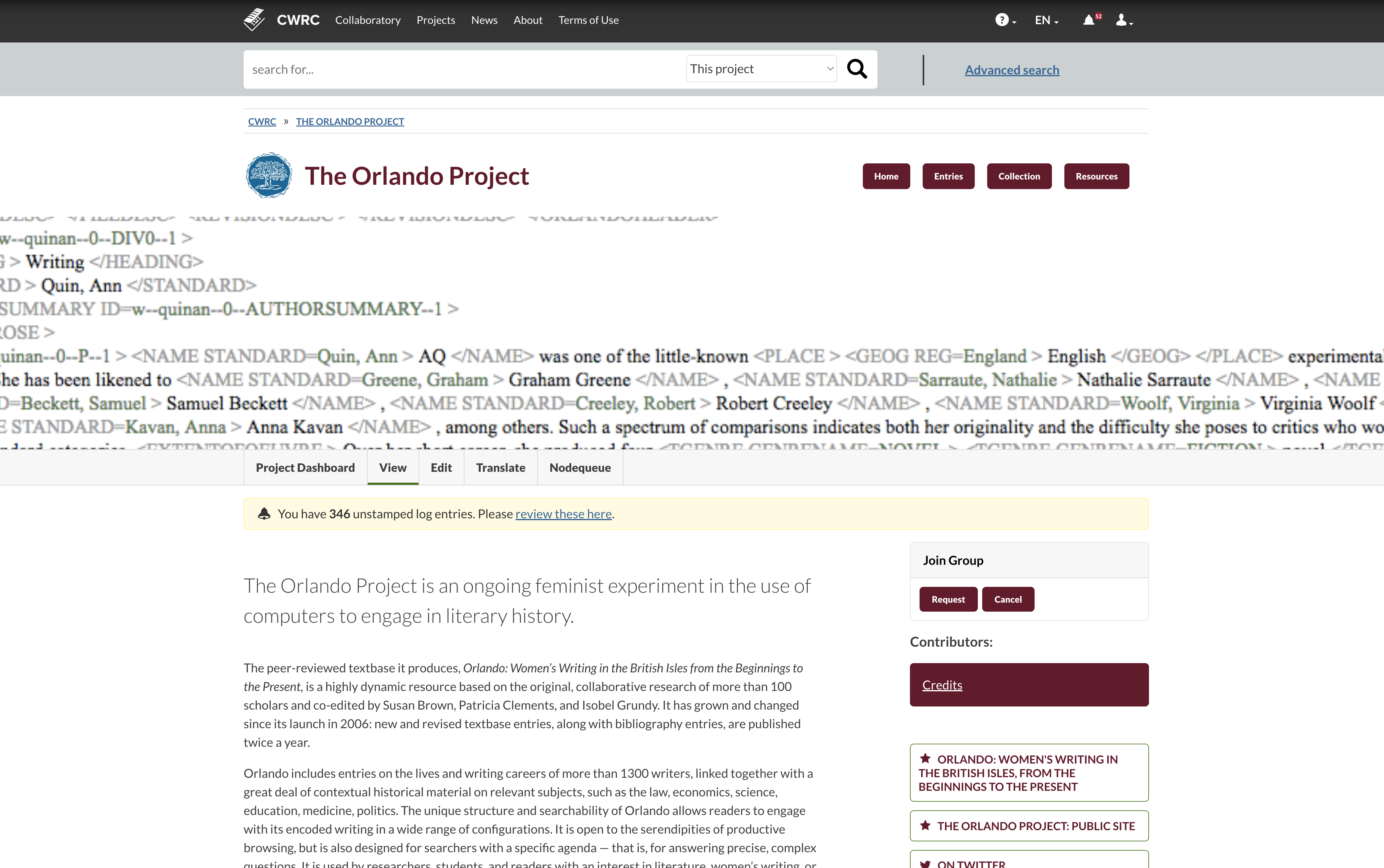 |
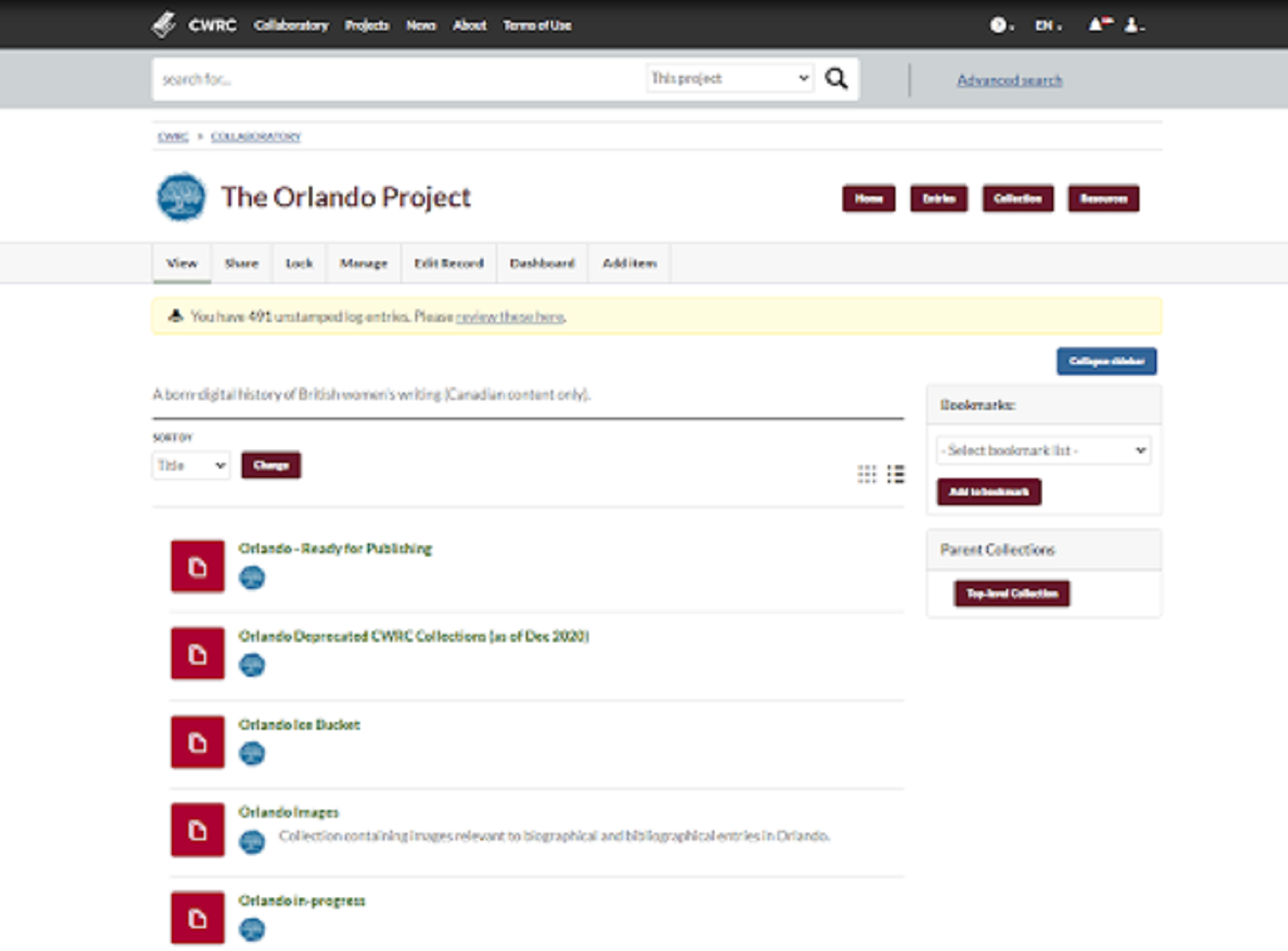 |
Figs. 2 and 3: Orlando Project production site homepage (l.) and collection’s directory (r.)
The Orlando team’s embrace of standards, thanks to the early guidance of Susan Hockey, has made it possible for a project begun in 1995 to move with the changing technological times, and to support ongoing scholarship. If imitation is the sincerest form of flattery, reuse is the digital scholarly equivalent. Orlando has been delighted to advance studies of women’s writing more generally by sharing data with the Women Writers Project at Northeastern University (directed by Julia Flanders), the Women’s Print History Project (directed by Michelle Levy), and Mapping Victorian Literary Sociability (directed by Karen Bourrier). Making our markup schemas open source means that they can be used by anyone wishing to join in the collaborative pursuit of feminist literary history.
The project’s technical innovations, as well as its scale and accuracy, account for the sense that it “has changed the parameters of the scholarship and teaching of British women’s writing” (Bowers, Scriblerian), that it assigns “narratorial agency to each user (Fraiman), and encourages researchers “to think in new ways” (Nixon).
Some of the more innovative experiments have run alongside the continuous work on the textbase, rather than intersecting with it. For instance, investigation of the large but dense network of connections embedded in Orlando began in 2007, resulting in the insight that if you factored in textual, organizational, and geo-spatial as well as personal connections, 88% of Orlando authors were linked by two or fewer steps, with 75% linked by only one. An award-winning prototype interface (Fig. 4) allowed users to explore the paths, usually multiple, by which any two authors were related.
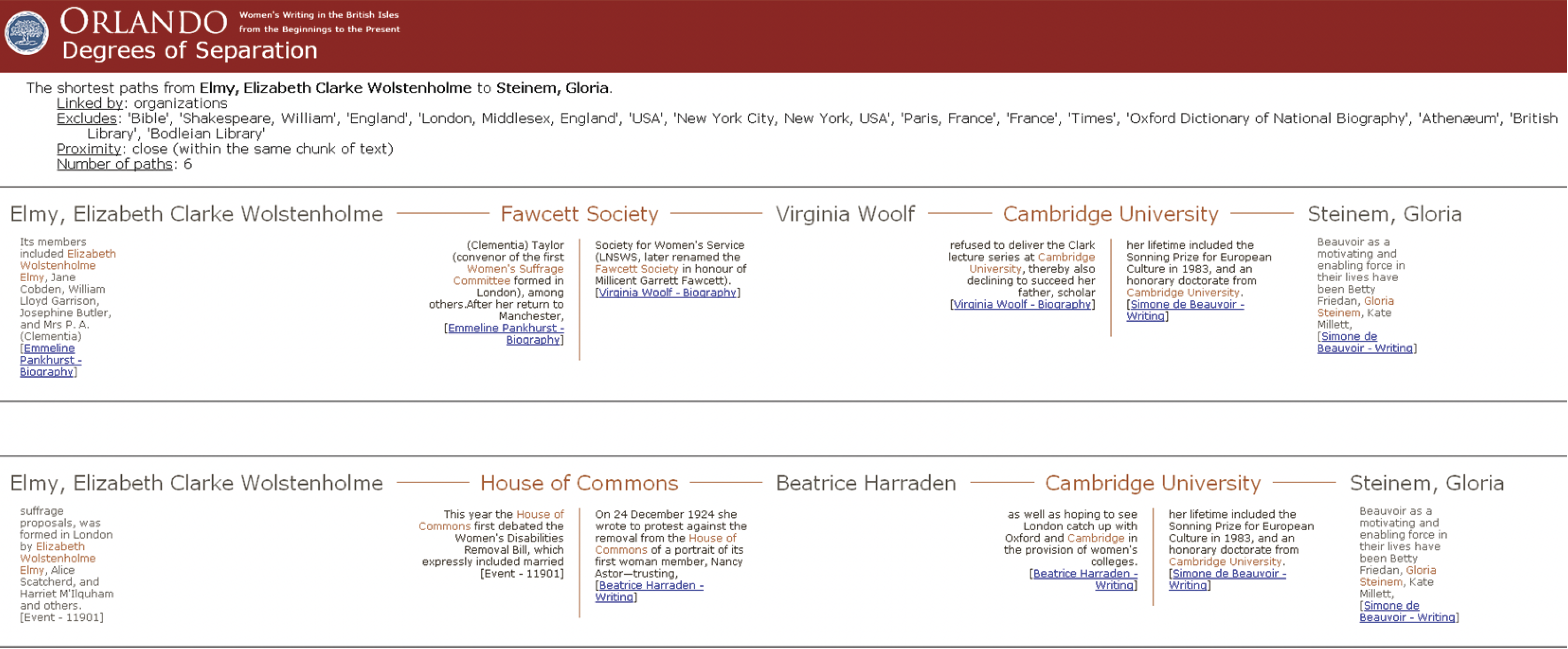
Fig. 4: Degrees of Separation prototype showing two of the paths between first-wave feminist Elizabeth Wolstenholme Elmy and second-wave feminist Glora Steinem.
A series of experiments with visualizing those connections led to first the OrlandoVision prototype, which proved useful for investigating topics including Victorian journal networks, late-Victorian feminism, and the institutions of modernist feminisms (see Elford, Brown, Bauer, et. al.; Brown; Holland and Elford).
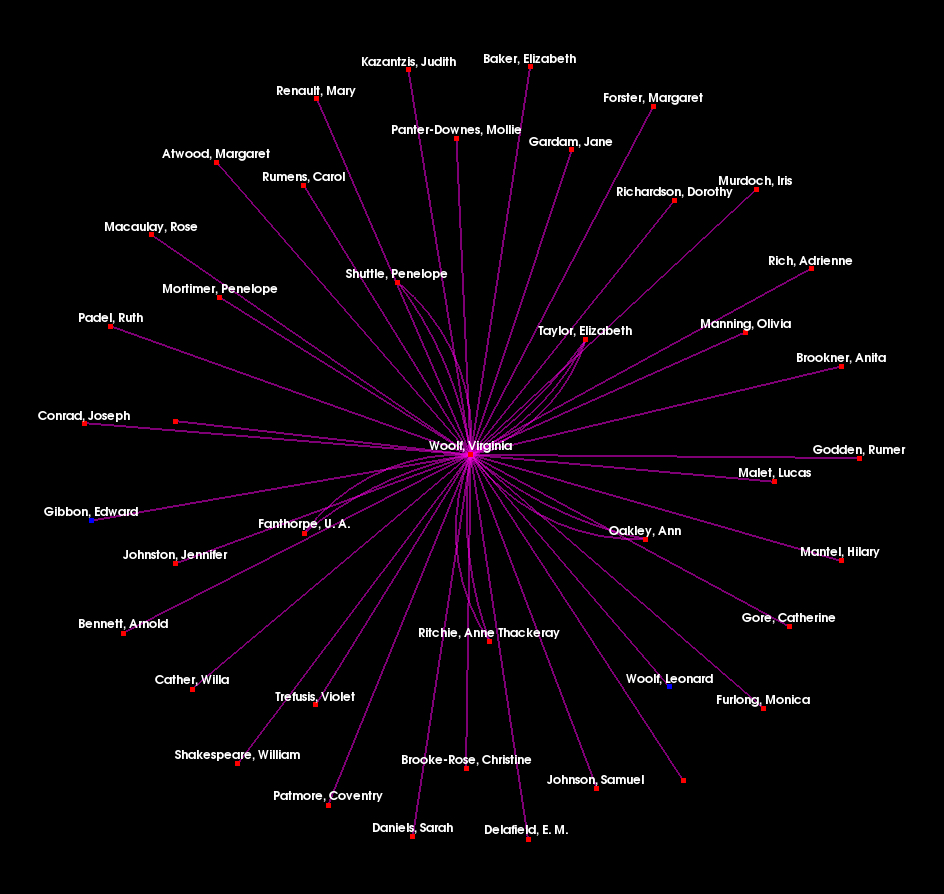 |
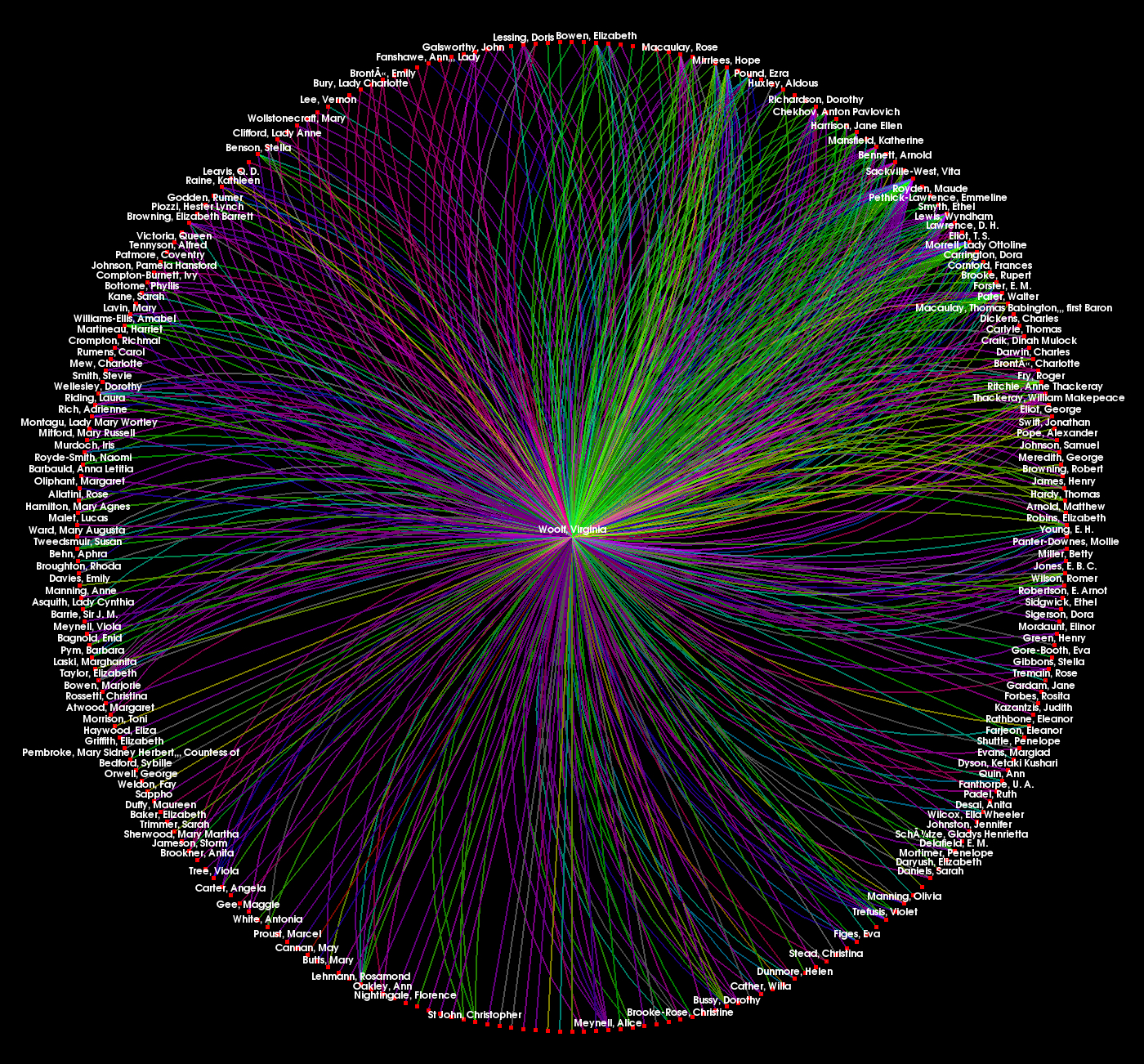 |
Figs. 5 & 6. OViz network visualizations of intertextual connections between Virginia Woolf and other authors with profiles in the Orlando textbase (left) and all of Woolf’s connections to other authors (right).
OViz was succeeded by the HumanitiesVisualizer (HuViz), a generic open-source browser for linked open data that aims to support serendipity within digital information environments (Martin). Its affordances for representing and exploring intersectional identities within Orlando data align with what Alan Liu has called the “diversity stack” needed by the humanities.
We are excited that the revised Orlando interface will allow us to close the gap between the Orlando textbase and this experimental work such as this: we look forward to gradually augmenting the interface with new points of access to our take on literary history, including graph visualizations and maps and a visualization for the Connections screen. Much of this new functionality will be the fruit of creating linked open data to complement the textbase, and so we were delighted that someone on Wikidata, the most active community in this space, saw fit to make Orlando’s author identifiers into Wikidata author IDs: this means that Orlando will interlink more readily with other open data on women’s writing within and beyond Britain.
This new chapter in the Orlando Project’s experiment is thus characterized by increased openness and better accessibility. As it becomes easier systematically to link up resources on women and writing from across the Web, it will become increasingly feasible to support bolder, synthesizing perspectives, and base broad claims on bodies of evidence both granular and deep.
We welcome feedback, contributions, and collaborations in the larger project of an intersectional feminist literary history that works across national categories and across the diverse understandings of women and writing, historical and contemporary.
Katherine Binhammer, Susan Brown, Patricia Clements, Isobel Grundy, and Kathryn Holland
Edmonton and Guelph, March 2022
References
Battershill, Claire, Alice Staveley, Helen Southworth, and Elizabeth Willson Gordon, “Collaborative Modernisms, Digital Humanities, and Feminist Practice,” Modernism/modernity Print +, Vol. 3, Cycle 2 (August 2018). DOI:10.26597/mod.0056.
Bigold, Melanie. Review of Orlando, ABO: Interactive Journal for Women in the Arts, 3:1 (April 2013).
Bowers, Toni. "Exploring the Richardson Circle using the Orlando Database", The Scriblerian, 44:2, 45:1 (Spring and Autumn 2012), 56-8.
Brown, Susan. “"Networking Feminist Literary History: Recovering Eliza Meteyard’s Web." Virtual Victorians: Networks, Connections, Technologies, Ed. Veronica Alfano and Andrew Stauffer, Springer, 2016, 57-82.
Brown, Susan, Patricia Clements, Isobel Grundy, Sharon Balazs, and Jeffrey Antoniuk. “An Introduction to the Orlando Project.” Tulsa Studies in Women's Literature Vol. 26, No. 1, The Silver Jubilee Issue: What We Have Done & Where We Are Going (Spring, 2007), pp. 127-134.
---. “The Story of the Orlando Project: Personal Reflections.” Tulsa Studies in Women's Literature
Vol. 26, No. 1, The Silver Jubilee Issue: What We Have Done & Where We Are Going (Spring, 2007), pp. 135-143.
Canadian Writing Research Collaboratory. Director Susan Brown. cwrc.ca.
Cope, Virginia. “Orlando, ECCO, and the (archival) gothic quest.” American Society for Eighteenth-Century Studies conference. San Antonio, 22-24 March 2012.
Elford, Jana Smith, Susan Brown, Michael Bauer, Jennifer Berberich, and Jonathan Cable. “‘Elevating Influence’: Victorian Literary History by Graphs.” Victorian Institute Journal Digital Annex 38 (2010).
Fraiman, Susan. “In Search of Our Mothers’ Gardens—With Help from a New Digital Resource for Literary Scholars.” Modern Philology 106, no. 1 (August 2008): 142–48. DOI: 10.1086/597254.
Harris, Jenine K., Merriah A. Croston, Ellen T. Hutti, and Amy A. Eyler. “Diversify the syllabi: Underrepresentation of female authors in college course readings.” PLOS ONE 28 October 2020. DOI: 10.1371/journal.pone.0239012.
Harner, James. Literary Research Guide: An Annotated Listing of Reference Sources in English Literary Studies, 5th ed. New York: MLA, 2008.
Hickman, Miranda. Review of Orlando. Tulsa Studies in Women’s Literature 27, no. 1 (2008): 180–86.
Holland, Kathryn and Jana Smith Elford. “Textbase as Machine: Reading Feminist Modernism with OrlandoVision.” Reading Modernism with Machines, edited by James O’Sullivan and Shawna Ross, Palgrave Macmillan, 2016, pp. 109-34.
--- and Susan Brown. “Project | Process | Product: Feminist Digital Subjectivity in a Shifting Scholarly Field.” Bodies of Information: Intersectional Feminism and Digital Humanities, edited by Elizabeth Losh and Jacqueline Wernimont, University of Minnesota Press, 2018, pp. 409-433. DOI: 10.5749/
Laity, Cassandra. “Editor’s Introduction: Toward Feminist Modernisms.” Feminist Modernist Studies, 1:1-2 (2018): 1-7. DOI: 10.1080/24692921.2017.1390870.
Levy, Michelle and Mark Parry. “Distantly Reading the Romantic Canon: Quantifying Gender in Current Anthologies,” Women's Writing, 22:2 (2015): 132-155.
Liu, Alan. “Toward a Diversity Stack: Digital Humanities and Diversity as Technical Problem.” PMLA 135.1 (2020): 130-151. DOI: 10.1632/pmla.2020.135.1.130.
Looser, Devoney. “British Women Writers, Big Data, and Big Biography: 1780-1830.” Women’s Writing 22.2 (2015): 165-171/ DOI: 10.1080/09699082.2015.1011838.
Mapping Victorian Literary Sociability. Director Karen Bourrier. University of Calgary. www.victorians.ucalgary.ca.
Martin, Kim, Susan Brown, Chelsea Miya, and Shawn Murphy. “Humanities-Centered Design Features: Emergent Serendipity with HuViz.” DH 2019 conference. Utrecht, 9-12 July 2019.
Nixon, Cheryl. “A Sampling of Results” in “The Orlando Project (review).” Eighteenth Century Fiction 22:2 (Winter 2010): 371-379. DOI: 10.1353/ecf.0.0123.
Orlando Project (entire team). “Sorting things in: Feminist knowledge representation and changing modes of scholarly production.” Feminisms and Print Culture special issue, edited by Maria diCenzo. Women’s Studies International Forum vol. 29, no. 3, May 2006.
Wernimont, Jacqueline. “Whence Feminism? Assessing Feminist Literary Interventions in Digital Archives.” Digital Humanities Quarterly 7, no. 1 (Winter 2013). Accessed 11 November 2020. http://www.digitalhumanities.org/dhq/vol/7/1/000156/000156.html.
Women Writers Project. Director Julia Flanders. Northeastern University.http://www.wwp.northeastern.edu.
Women’s Print History Project, 1750–1830. Simon Fraser University. Director Michelle Levy. https://michellenancylevy.wordpress.com/research/womens-print-history-project-1750-1830/.
